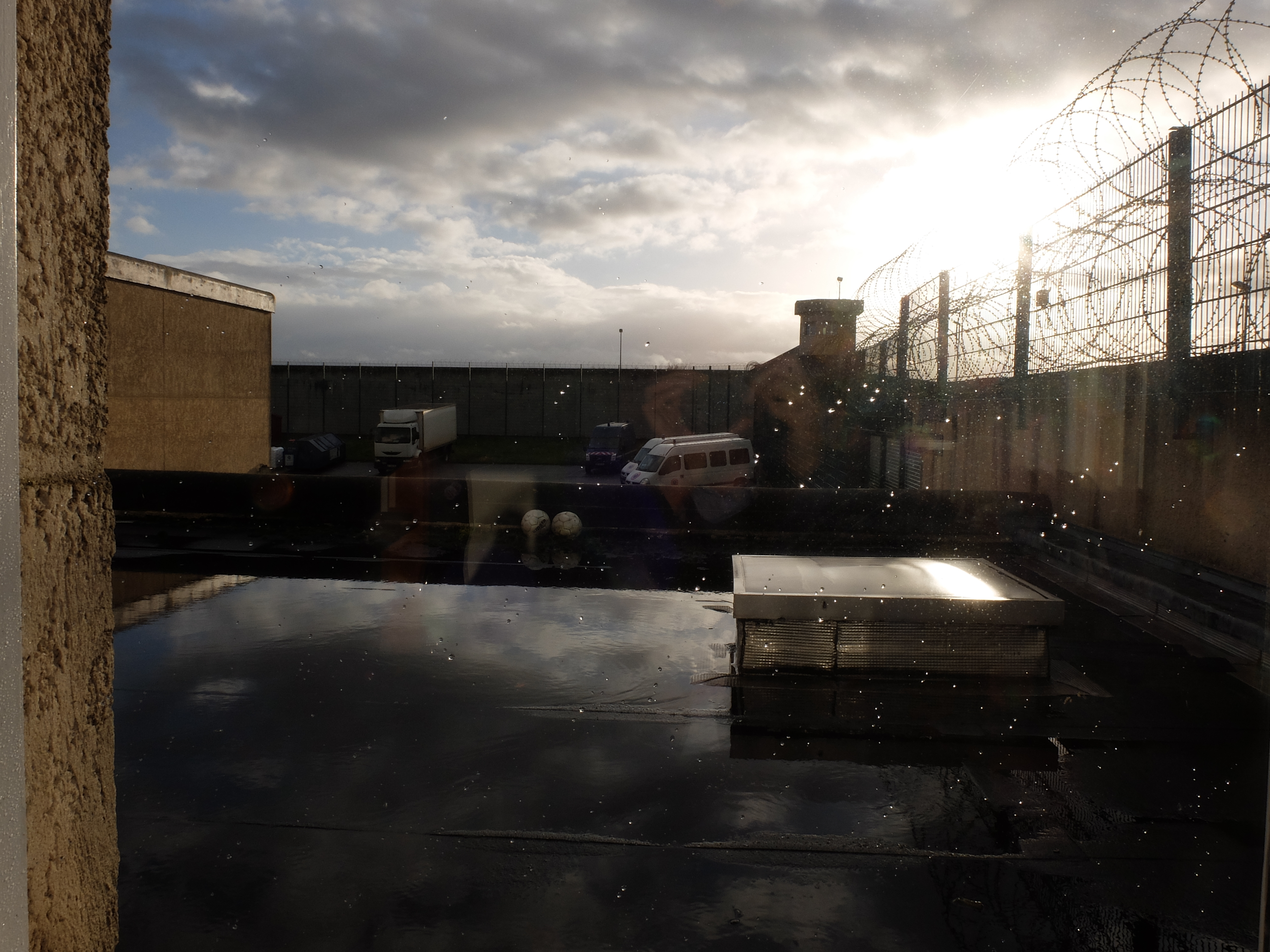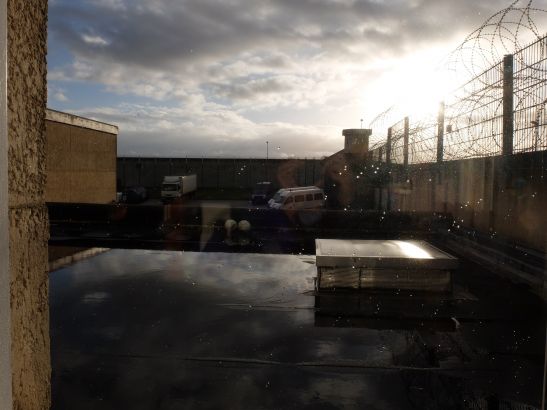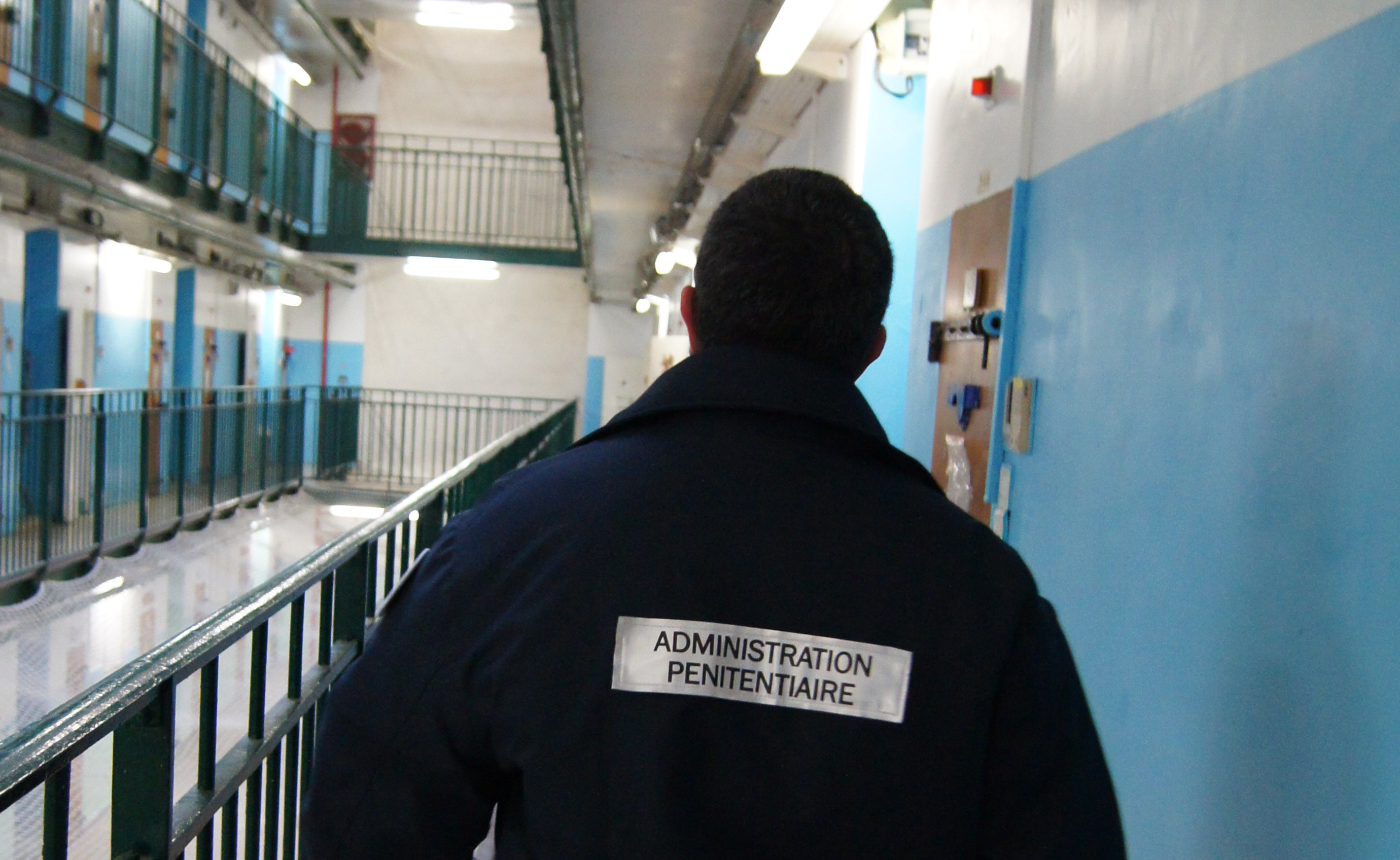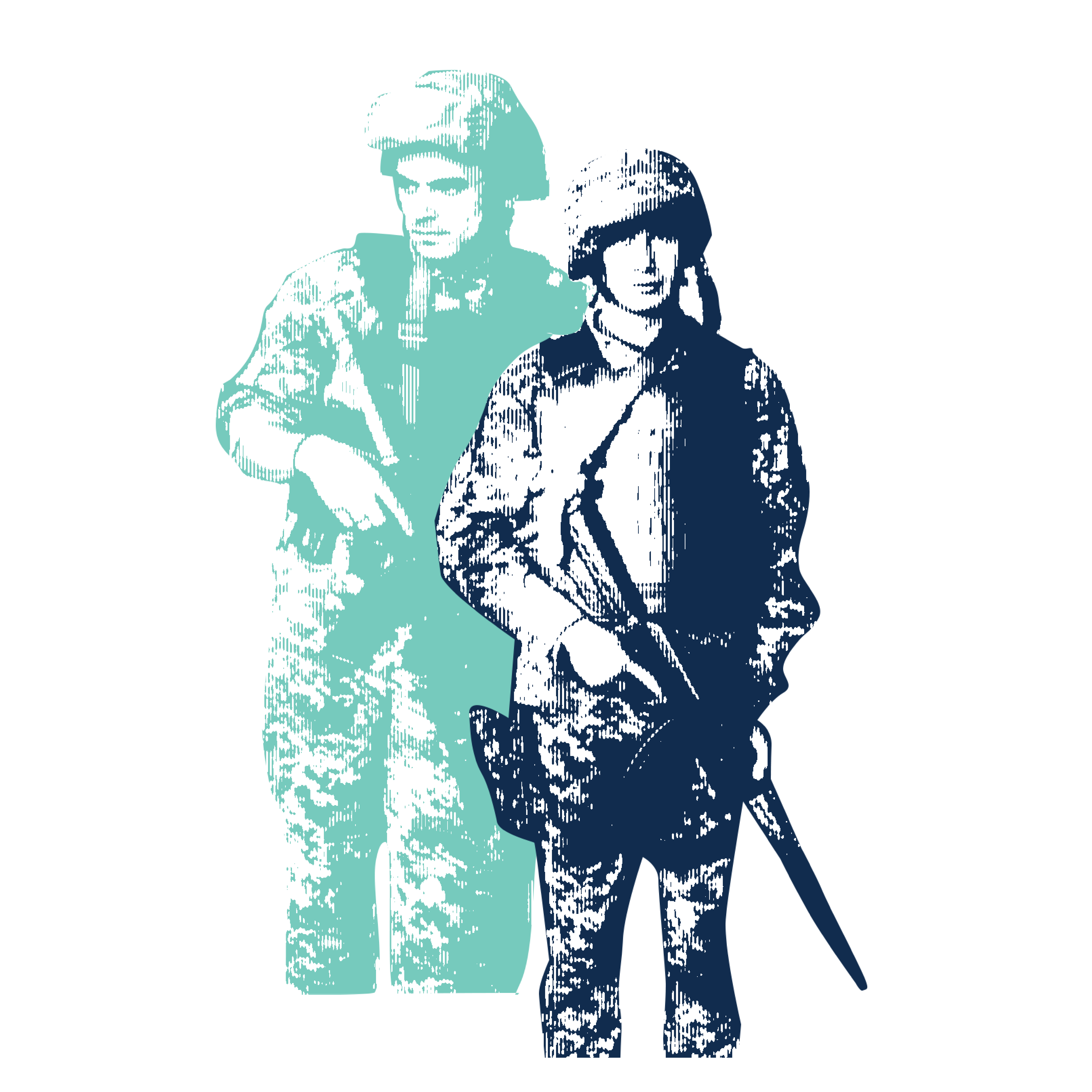
A goldfish was being looked after by the warders when I visited the prison at Osny, just outside Paris, last month. It swam around a small bowl in the administrative office. "It was confiscated from one of the cells," said the warder, glancing up from her desk. "A lot of things get into prison that shouldn't."
"No pets allowed at Osny, then?"
She smiled. "Only rats."
A guard let us through the barred gate outside the office, into the high-security section of the jail. Down the narrow, low-ceilinged corridor we filed – a handful of French journalists and I, accompanied by several grave, soberly-dressed, officials. We passed a small window, which looked out onto a wall surmounted by concertina wire.
Over the past few weeks, the prison at Osny has become a testing ground for France's most controversial new plan to combat Islamic radicalization. In February a "dedicated unit" opened within its walls, expected to receive 20 violent or potentially violent extremists. A similar unit has also come into operation at Lille, in northern France, and one at Fresnes, just south of Paris. Two more have opened at Fleury-Mérogis – Europe's biggest prison, also in the Paris region.
The prisoners in these new anti-radicalization units will enjoy resources that put the rest of the penal system to shame. They will be supervised by a larger-than-usual complement of warders, trained in the rudiments of Salafism, and they will receive visits by sociologists, psychologists and historians (to argue against their rose-tinted ideas about medieval caliphates). The routine for these men will include theater workshops, political discussions and lessons in the prison school – reading and writing for the barely literate, Japanese for the intellectually advanced. (Those who refuse to get into the spirit will be expelled back to the less salubrious environs of the prison system proper.)
These inmates are not the most dangerous: those whose jihadi certainties are so ingrained that the system regards them as beyond hope. The detainees who will enter these units are considered dangerous but salvageable, but no one knows for sure if this is the case – just as no one knows if the new units are the solution to the problem. There is even disagreement over what the problem is.
Over the past few years it has become a common belief that prison radicalization is the most dramatic manifestation of a wider problem: the vehement rejection by many young French Muslims of what they see as a xenophobic and impious French republic. As France's media and politicians do not tire of pointing out, some of the worst recent atrocities on French soil have been committed by men who were "radicalized" behind bars.
The unsatisfactory word "radicalization" fails to convey the complexity of a phenomenon that still affects only a small number of people. The process by which committed jihadis prey on impressionable people, guiding them first to a virulent Islamism, then to violence, can take years. It may be accompanied by intense piety. Then again, it may not. It can affect the well educated and the unlettered. It usually involves a gradual political alienation from the values of the state and a dulling of the ability to feel another's pain. (Radicals, I was told repeatedly by probation officers, are marked by an inability to empathize.)
A little further down the corridor, we reached the pic, a circular observation point protected by thick glass. Renaud Seveyras, the governor, guided us down one of the corridors angling off it. "Welcome to the dedicated unit," he said, and showed us into an unoccupied cell so we could admire the freshly painted walls, the toilet cubicle with newly installed saloon doors, the TV and fridge.
Five of the other cells on the corridor were locked shut. They contained the first inductees into the dedicated units. From behind one emanated the strains of a sung Arabic prayer. The radio journalists hunched outside in order to record the sound.
At the far end of the corridor Seveyras showed us into the small rectangular exercise yard that has been built for the prisoners – into which, he said, it was impossible for anyone to lob packages from outside the perimeter fence. In 2014, the authorities at Osny seized more than 1,000 mobile phones that had entered the jail, many by the aerial route. These devices are banned because they allow gangsters to stay in touch with their networks and radicals to access extremist content online. (A recently freed prisoner told me that the IS flag is the phone wallpaper of choice for the newly radicalized.)
After we had visited the jail's multi-faith prayer hall ("It hasn't been defaced since its inauguration in 2003," Seveyras said proudly), we trooped upstairs to the governor's office, where we were joined by Geraldine Blin, a woman whose soft, even tender manner seemed to belie her position as commissar of anti-radicalization inside French jails.
Sitting comfortably, drinking our coffee, it was easy to forget that this simple journalistic exercise almost never happened. Twice in as many weeks, our expedition to Osny had been cancelled precipitately, as the government struggled to find the appropriate way to announce its new policy – indeed, struggled to decide whether to announce it at all.
This is the shivery new France – post-Charlie, post-Bataclan – in which public support for hardline security measures introduced by the government is overwhelming, apprehensions about the rise of Islamism shade into xenophobia, and the worst crime of which any public official can be accused is laxisme. The rightwing contempt for any efforts to "understand" the causes of terrorism has been adopted by key figures in the Socialist government, including the prime minister, Manuel Valls. In the aftermath of last November's attacks he rounded on those who "seek excuses or cultural or sociological explanations for what happened".
The government's response to last year's atrocities has been accordingly tough. Immediately after Charlie Hebdo, the government announced that it was putting €425m into anti-terror measures – mostly personnel and equipment for the security forces. In May 2015, parliament passed a law allowing the intelligence agencies to tap phones and emails without permission from a judge. After the November attacks, President François Hollande instituted a state of emergency under whose provisions civil administrators – not judges – have ordered more than 3,000 searches of premises and issued 400 house arrests. The targets of these measures have almost all been Muslims (as are most of the subjects of the bag searches and frisking that police carry out in town centers) and almost none have been accused of any terrorism-related crime as a result. The effect on civil liberties has been crushing, and Muslims across the country have complained to human rights organizations that they are being systematically profiled.
But the polls show that this approach is popular. Almost 80% supported parliament's recent vote to extend the state of emergency until May. There has been similar, overwhelming support for a government bill, now before the Senate, that would strip terrorists of their French citizenship. Public opinion is becoming more authoritarian. A poll conducted in May 2015 showed that 52% favored the restoration of capital punishment, an increase of seven percentage points on the previous year.
Prisons are a reflection of the societies they serve. You would expect French policy to run along similar lines in both, but this is not what is happening. At precisely the moment when official attitudes are toughening in the country at large, in the nation's jails the anti-radicalization units may signal a new, more supple approach.
Key to their success will be precise observation and evaluation. The first weeks are when detainees are most at risk – either to suicidal feelings or proselytization. The prison intelligence service, which collates information on electronic dossiers stored in the pic, must determine whether a given prisoner is having a malign effect on the others. (If he is, he may be expelled from the unit.) But Blin is thinking more ambitiously, about the fissures in society at large. "If we can show these people that society is interested in them," she said, "it's possible the tear can be repaired."
For all Blin's enthusiasm for understanding these menaces to society, the animating principle behind the new units is not philanthropic, but practical. The majority of the detainees housed within them have been incarcerated for "criminal association in connection with a terrorist enterprise" – a portmanteau charge that encompasses fighters who have traveled to Syria and the administrators of jihadi websites alike, and carries a maximum sentence of 10 years. Before very long, the men behind the locked cell doors – men considered too dangerous for us to meet – will be out. Can the country's prisons solve a problem that the wider society has utterly failed to repair?
The terrorist attacks of the last year—and the fact that most of the perpetrators were French citizens – have induced a nationwide panic about "homegrown" terrorism and the radicalization of France's Muslim minority. On 3 February, a banner headline in the rightwing Le Figaro, France's second-largest newspaper, announced that the Interior Ministry had identified 8,250 French people who had been "radicalized". The story went on to report that this represented a more than 100 percent increase on the March 2015 figure. What it neglected to say is that this remains an infinitesimal proportion of France's estimated Muslim population of 4.7 million, still less its total population of 66 million.
Confronted with the frightening prospect of a minority population alienated from the Republic and susceptible to the lures of an anti-state Islamism, it is no surprise that French public opinion has latched on to the issue of prison radicalization. That prisons have a radicalization problem is not in doubt, but it may also seem an easier task to fix arrangements in prisons than to repair the societal rift between France and its Muslims.
Muslims constitute a disproportionate majority of the French penal population—an estimated 60 percent, as opposed to 8 percent in society at large—and the proportion of Islamic radicals among the country's 68,000 prisoners is growing. During a visit I made in January to the prison at Fresnes, in the southern suburbs of Paris, the governor, Stephane Scotto, told me that he had identified 43 radicals in his jail—up from 10 at the beginning of 2014.
Critics of bunching Islamic radicals together in dedicated units fear that, far from shielding the mass of detainees from contagion, they may create ghettos of hardened extremists. Mourad Benchellali, a former French detainee at Guantánamo Bay who now goes into jails to combat radicalization, told me that "ill-intentioned" inmates of the new units might prey on weaker detainees, "taking them towards jihad".
Broadly speaking, the right approves of segregating radicals—in effect, taking them even more out of society than they already are—but takes less interest in rehabilitating them; the left is inclined to the reverse. (The former justice minister, Christiane Taubira—who resigned on 27 January in protest at the government's plans to strip terrorists of their French citizenship—expressed "grave reservations" over the principle of grouping radicals together.) The creation of the new dedicated anti-radicalization units, then, is something of a political fudge: both sides agree something must be done, if not why.
One of the problems in the French debate about radicalization is that no one can agree on what constitutes a radical. I have been quoted figures ranging from 1,000 to well over 2,000 radicals inside French prisons (including some 240 people who have been accused or convicted of terrorism). But some in this group may be inside for something as anodyne as non-payment of alimony. Others have visited extremist websites. Does that put them in the same category as the 1,000-odd Frenchmen and women who have gone to places – mostly Syria and Iraq – where jihad is currently being fought?
When sharing a tiny cell with two or three others, the weaker cellmates are clearly at risk of being indoctrinated by stronger ones. (France's prison watchdog noted there were 928 prisoners for 580 places at Osny in a report last June; the dedicated units are exceptional in providing single-occupancy cells.) An extremist agenda can advance quickly as a result of the isolation, boredom and anger that a young man feels in jail; a captive Muslim population clearly presents opportunities to the would-be radicalizer.
Several notorious examples bear this out. Mohammed Merah, who killed three soldiers, three children and a rabbi on a shooting spree in 2012, became a Muslim radical during his frequent incarcerations for delinquency. The same is true of Mehdi Nemmouche, who launched a deadly attack on the Jewish Museum in Brussels in 2014. Two of the authors of the Paris attacks of January 2015, Cherif Kouachi and Amedy Coulibaly, shared the same hardline mentor while they were at Fleury-Mérogis in 2005. That said, last November's much more costly attacks were carried out by people who had not been to prison. And who is to say Merah, Nemmouche and the rest would not have become radicalised on the outside?
The first attempt to combat prison radicalization in a systematic manner was undertaken two years ago by Stephane Scotto, the governor at Fresnes. He had become alarmed by a huge increase in reports that radicals were imposing their values on less pious fellow prisoners – stopping them from smoking or listening to music, abusing them as "heretics" in the exercise yard. In October 2014 he grouped them together in a specially designated "unit for the prevention of terrorism".
According to Scotto, tensions relaxed across Fresnes following his measure, but the proselytisation did not stop. Fresnes's huge cellblocks are arranged in parallel, allowing prisoners to call to each other out of their cell windows. Many prisoners have smuggled in mobile phones and others have learned the knack of attaching messages to yo-yos and launching them into adjacent cells. It is notoriously difficult to separate prisoners entirely from each other or the outside world.
Among those radicals whom Scotto isolated, a sociologist familiar with Fresnes told me, were a number of "brilliant orators". These men were now living alongside weaker men whose radical sympathies had not yet hardened into a true propensity for violence. The nightmare scenario of charismatic proselytizers working on impressionable detainees played out with catastrophic effects. A warder at Fresnes described Scotto's unit as a "finishing school" for extremism.
When I met him, Scotto was clearly frustrated by the tendency of the public to blame prisons for a phenomenon that is manifest across society, and which has been expediently laid at his door. "Are we expected to succeed where schools, families and local associations have failed?" he asked.
As well as receiving transfers from other institutions, prisons in France tend to serve their local communities, and reflect their social make-up. This is certainly true of the prison at Osny. The department in which Osny lies, the Val d'Oise, is notable for high youth unemployment, disaffection with the French republic and the growing popularity of Salafist ideas. In 2007, in the commune of Villiers-le-Bel, the death of two youths after their motorbike was struck by a police car led to several days of street fighting in which 100 policemen were injured, some of them by live rounds fired by protesters. In the tense aftermath of last November's attacks, local police launched some 200 raids on suspected radicals in the area, though only about 20 arrests were made.
The prison at Osny manifests all these societal problems in concentrated form. In a report last June, the prison watchdog, the CGLPL, referred to 12 inmates who are incarcerated there for terrorism. Among them are six returnees from Syria, a man who is serving eight years for administering a jihadist website and an amateur chemist who had accumulated the wherewithal to make bombs. The report continued: "A further 20 detainees who have been incarcerated for [non-terrorist] criminal acts have also been identified as radicalised."
According to the CGLPL, these radicals have developed "new friendships" with other detainees who are incarcerated for non-terrorist criminal offences. This has allowed "classic delinquents to … consider themselves absolved of the facts of their criminality". In other words, gangsters and murderers feel that they have been pardoned by God because condemned or suspected terrorists tell them so.
At some point in the process by which radical Islamists take over an institution, an atmosphere of intimidation occludes any spirit of coexistence. This point seems to have been reached at Osny. The CGLPL says that between 10 and 15 Muslims are "expelled" by their cellmates each year for being insufficiently devout. (What it does not say is that this sanction requires the tacit cooperation of the prison authorities – they must arrange for the ostracized men to have new accommodation.) Women who wear halter tops or jeans to visit their detained loved ones are often insulted by Islamist prisoners for their "lewd" mode of dress, and some have started covering up before entering the prison.
That Osny is being taken over by extremist ideas is not news to Nsangou Ntchara Mamadou, the former imam of the prison, whom I visited at his home in the nearby commune of Taverny. Nsangou is a relic of France's earlier, paternalistic engagement with Islam, which involved instructing biddable men from the former colonies in the values of the republic. He is a kindly, elderly Cameroonian who espouses ecumenism and whose front room (which doubles up as a mosque for the Muslims of Taverny) is adorned with the tricolor.
Nsangou was imam at Osny when the jail's interfaith prayer room was inaugurated in 2003. "I would walk down the corridors arm in arm with the rabbi and the Catholic chaplain," he recalled proudly. "I called them my brothers." One Friday in 2007 a Figaro journalist listened as Nsangou exhorted his congregation to avoid "rebellion, terrorism and violence".
Nsangou was the state's man, and if he heard a prisoner expressing radical views, he would report him to the administration. It is easy to see how he angered the Muslims of Osny—and how they ended up boycotting him. The imam, shuffling sadly around the room in his djellaba, dug out old lists of inmates who had signed up to attend Friday prayers during his time at the prison. In 2008 the number was 49. By 2012 it had fallen to 29. In 2014—his final year at Osny—it was two.
Although the religious complexion of French prisons has been changing for several decades, the Republic's policy of not identifying the faith of its citizens meant that few noticed. The illusion of stability was reinforced by the historic association that the prison service, despite being an arm of the secular state, enjoys with the Catholic church. Many 19th-century prisons (such as Fresnes) were built with chapels attached, and even today hundreds of chaplains are on hand to attend to the spiritual needs of detainees.
The radicalization of French prisoners began in earnest in the mid-2000s. Prisons were receiving significant numbers of Muslims who had been educated in France, and were well aware of the state's obligation to facilitate the religious expression of all its citizens. They began demanding privileges of their own: imams, a space to hold Friday prayers, and halal food. (Osny, which already had an imam—Nsangou Ntchara Mamadou—and an interfaith prayer room, was somewhat ahead of the curve).
The more militant of these prisoners prostrated themselves in the exercise yard, blared the call to prayer from their cell windows and declared their support for Osama bin Laden. These actions were often punished with an immediate transfer or a spell in isolation.
But life in prison was starting to change under the influence of the caids – leaders of the new trend towards a more forceful assertion of Muslim identity. Typically charismatic young men with resplendent beards, they told their fellow prisoners to keep their underpants on while showering, and proscribed watching women's sports on TV in the cells. Detainees signaled their piety by refusing to address female warders. The Ramadan fast, formerly a minority activity, grew to the point where it came to take over life in some jails for a month every year, with much reading of the Qu'ran and a logistically demanding distribution of halal food parcels in preparation for the breaking of the fast at dusk.
The recollections of Kamel, an ex‑prisoner I met twice this winter, shed light on this period of rising religiosity. Kamel is a slight, self-assured man in his early 30s. He was freed from a jail in central France in 2014, after serving seven years of a 10-year sentence (he did not wish to divulge his crime to me). "The Muslims in jail never ask you what you've done," he said approvingly over kebabs in the suburban restaurant where we met. "They say it's between you and God."
Kamel had grown up in the south of the country, in a family of North African background. Religion played no part in his upbringing, which he described as "pretty much atheist", but he found the faith of his forefathers while in jail, as a result of his friendship with Yacine (not his real name), a violent Islamist.
"We met in the exercise yard," Kamel said. "He was a small, inoffensive sort of guy, but I found out he was serving 15 years for terrorism. He was capable of chopping off heads – not that he spoke of things like that, but when he said he didn't like the country and hoped to leave, it was obvious what he meant."
The Muslims in the jail had won the right to congregate for Friday prayers, but there was no imam, so, as Kamel recalled, Yacine stepped in. "He took it on himself to deliver the sermon, and he did that five or six weeks running before the administration stopped him."
Although he was no longer allowed to deliver sermons, Yacine had established himself as a religious authority. Prisoners began coming to his cell and soliciting his fatwas, or opinions, generally on matters of everyday observance. For a man who had received no formal training—a man whom most Islamic experts would regard as scandalously unqualified—he had come far.
Yacine clearly posed a dilemma for the administration. As Kamel put it, "he wasn't the kind of guy to cause trouble, to deal cannabis or get into fights." But his agenda was insidious: a slow-burn conversion to a very aggressive form of radicalism. "To begin with, he persuaded his targets to accept the truth of Islam. Then things went forward, little by little."
Alarmed, the prison authorities started monitoring Yacine closely. He sent word to Kamel not to approach him in the exercise yard—otherwise Kamel, too, would attract unwelcome attention from the authorities. All the while, other Islamists were taking over different parts of the jail. The football pitch became a symbolic battleground. "If you wanted to play," Kamel said, "they told you to wear shorts below the knee."
Kamel stressed to me that although he became an observant Muslim under Yacine's influence, he was strong enough to resist the other man's summons to militancy. For Kamel, Islam seems to have been a support that got him through a long prison sentence. But it also had political meaning, allowing him to hit out at a state he hated. "One day," he laughed, "we got six people into a single cell to pray." (The prison authorities regarded unauthorized congregations of this sort as an illicit "collective action".)
In the course of our conversations, Kamel mentioned white converts to Islam he had met in jail. Another former prisoner, remembering his time behind bars at Lens, described a man called Juan who converted, renamed himself Bilal, and announced: "I want to do jihad." These converts are a distinctive—and growing—feature of French prisons. They are derisively known as petits blonds by the black and North African majority.
Ahmed el-Houmass, a burly warder at Fresnes, a practising Muslim and an official of the public sector union, the CGT, described one such convert—before and after the moment of his conversion. "His name was Stephane. Both his parents were doctors. He was top of the class. He parted his hair at the side. You know the type. But then he mowed down a little girl when drunk-driving and got five years."
When Stephane arrived at Fresnes he experienced what El-Houmass called prison shock: "He spent the first two weeks weeping like a baby." One day an Algerian prisoner called Mohamed went up to Stephane in the yard and asked why he was crying. Thus began Stephane's journey. According to their ex-warder, "Mohamed was promising him forgiveness for what he had done. Stephane was in two minds. His parents were Catholic. They would not take it kindly. But Mohamed gave him books and CDs." Within another two weeks Stephane had converted and was growing a beard.
El-Houmass believes that the "blind faith" and isolation of converts such as Stephane increase their vulnerability to manipulation. "In the end I collared Stephane's parents in the visitors' block. I told them, 'Your son is going off the rails in a big way, he's radicalizing.' The father didn't believe me, but then his son arrived and he saw the beard." Stephane's parents immediately arranged his transfer to another prison.
Although Islam has continued to rise in jails across France, and radicalism with it, it would be wrong to assume that it is practiced consistently by new Islamists. For all the Islamist stress on observance, there are many born-again Muslims who continue to get high, listen to hip-hop and chat via Facebook with multiple girlfriends.
For some, putting on a radical front can be a means to an end. El-Houmass told me about a detainee at Fresnes, a non-smoker, who was desperate to get out of the cell he was forced to share with three smokers. The man's requests for a move went nowhere—Fresnes, like Osny, is very overcrowded. But this prisoner was aware that the administration had a policy of isolating radicals, and he turned this knowledge to his advantage.
"He amused himself over the course of a week by issuing the call to prayer—every day, at 5:00 pm. Pretty soon he was identified as a dangerous prisoner and given his own cell."
In the past 18 months or so the behavior of jailed radicals has changed significantly. Prompted by their caids, they are going to ground. In its most recent assessment of Osny, the CGLPL stated: "Since the end of 2014 instructions seem to have been given for [prisoners to] dissimulate so as not to display the outward signs of fundamentalism … calls to prayer issued from windows … have practically stopped, as have collective prayers. Instances of violence towards personnel have fallen. Outward manifestations of missionary activity have virtually disappeared."
This account chimes with those of the personnel I have spoken to at Osny. "The signs of radicalization are no longer wearing the djellaba or growing a beard," one warder said. Rather than proselytize directly and risk a spell in isolation, he explained, the caids increasingly deputize "lieutenants" to win over the impressionable.
According to a sports trainer at Osny, the most dangerous radicals nowadays "keep on good terms with the administration". The trainer, a tough, streetwise man from Marseille, said he had been able to observe many prisoners who have returned from IS territory in Syria, because they are all keen footballers. "I try and draw them out," he said, "but they never give an opinion, whether on religion or politics, because they're smart. I consider them dangerous because they're smart."
In recent months sociologists across the prison network have become sensitized to a new type – the "dissimulator", who after a period of aggressive behaviour suddenly adopts a friendly tone when addressing them, or who begins speaking to female warders after previously shunning them. But some prisoners hide their religiosity for different reasons: the hostility of the prison administration, and the fear that being labelled a pious Muslim will prejudice their chances of being let out on parole or allowed home for a visit.
This is a reflection of worsening mistrust between many Muslims and society as a whole. Under the state of emergency, men with beards and women in headscarves are more likely to be searched in public places than petits blonds. Hostile asides are an expected consequence of taking a walk. "You'll get your comeuppance!" one woman hissed at Kamel as he passed near the Bataclan shortly after the massacre.
Tension rose in the jails throughout 2015. Following the November attacks, detainees at Fresnes disturbed the minute's silence that was observed across the country with catcalls and oaths from their cell windows. Footage of this was posted on YouTube—a major breach of prison rules. The detainee responsible has since been transferred.
A former prisoner from Lille told me about another prison where warders reacted to the November attacks by launching frenzied searches of the cells of Muslim prisoners. "They were turned upside down," the former prisoner told me. "They were looking for books, USBs, any evidence of proselytization." But often the warders don't know the difference between proselytization and piety; their dragnet catches all.
Most French politicians agree that there is a difference between potential terrorists and devout Muslims who practice their faith legally. And yet, all too many people in public life and the media make no distinction between the two—they make an amalgame, in the language of French political science. By doing so, they are assisting in the radicalization of this second group. They are doing Isis's job for it.
Like so much else, the problem of the amalgame is intensified inside France's prisons. Many prisoners are reluctant to be considered for the dedicated anti-radicalization units – the extremist tag is hard to shed. A second apprehension that some prisoners have, and that Geraldine Blin has observed, is that fellow inmates who speak with mesmerizing authority on Islam and jihad will sap their will to reform. The mother of one detainee who fled Isis and is now at Osny, described her son as "very impressionable; I'm afraid they will destroy him". She has managed to convince the authorities not to move him to the dedicated unit.
Each deradicalization cycle is supposed to last six months, after which the participants return to ordinary prison life—though in theory they will be closely monitored afterwards. Yet quite apart from the wholehearted enthusiasm of the inmates, other things are lacking even before the process really gets going. Ideally, the families of radicals would be closely involved, helping to convince the detainee that a worthwhile life awaits him outside jail. But many of the radicals have untidy home lives and little connection to their family—these can be reasons why they became radicalized in the first place.
There are so many elements necessary if one is to put a man back together so he no longer threatens his fellow man, and it would be wrong, as Stephane Scotto said, to expect the prison service to rectify problems of alienation and resentment that exist in society at large. But my reporting on various pilot projects over the past few months suggests that there may be reason to believe that deradicalization inside jails is indeed possible – at least for some.
One probation officer told me the story of a jihadi who had revealed to her, apparently for the first time in adulthood, that as a child he had been raped by his uncle. This was important to the process of deradicalization, she went on, because "if you don't recognize your own suffering, you're not going to recognize that of others".
As part of an earlier pilot deradicalization scheme at Osny last year, a woman named Latifa ibn Ziaten came to speak to about 20 prisoners deemed at risk of radicalization. Among them, in all probability, were some admirers of Mohamed Merah—who murdered Ibn Ziaten's 30-year-old son Imad, a paratrooper, the first victim of his shooting spree four years ago. But to the surprise of the personnel who were present, the prisoners began confiding in this softly spoken, maternal figure, who did not excoriate Merah, but lamented that he had not grown up surrounded by love. (Merah's childhood was particularly barren in this respect.) They told her what crimes they had committed and confessed that they were afraid they might never be able to integrate with society and build a future. At the end of the exchange, everyone rose for a minute's silence in honor of Merah's victims. This one was flawlessly observed.
The trauma counselling; the hand of friendship extended by someone whom one might expect to be full only of hate—here, again, is the "understanding" that authoritarians in France find so repugnant. And yet the model that is now being pursued in the new anti-radicalization units – painstaking, individualized, demanding discipline and compassion in equal measure—could serve as an example for the rest of the country if it is to reintegrate disaffected Muslims into a republic whose values, in their view, are suffused with contempt for them. All too rare is the public servant who suggests that the police state being constructed by President Hollande, while perhaps keeping the French more secure in the short term, will in the long run only make them more vulnerable.

Education Resource
Meet the Journalist: Christopher de Bellaigue on French Prisons
In January and February 2016, grantee Christopher de Bellaigue spent several weeks researching...









